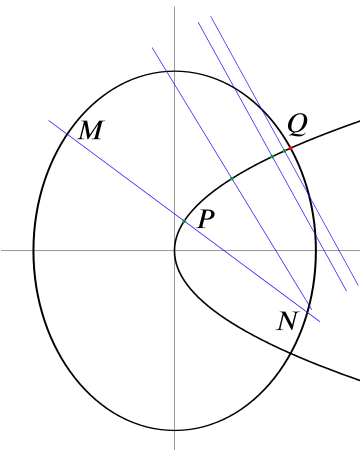The normal at a point \(P\) on the parabola \(y^2=4ax\) meets the ellipse \(2x^2+y^2=c^2\) in the points \(M\), \(N\). Prove that \(P\) is the mid-point of \(MN\).

Let’s find the equation of the normal through P. Let the point \(P\) have the coordinates \((at^2,2at)\).
Implicitly differentiating the formula for the parabola gives \[2 y \frac{dy}{dx} = 4a \qquad\implies\qquad \frac{dy}{dx} = \frac{2a}{y} = \frac{1}{t}\] and so the normal has slope \[m = \frac{-1}{dy/dx} = -t.\]
Then the equation of the normal is \[y - 2at = -t(x - at^2)\] or \[y = (2a - x + at^2)t.\]
Substituting into \(2x^2+y^2=c^2\), we find that at the points \(M\) and \(N\) \[2x^2 + (2a - x + at^2)^2 t^2 = c^2\] which we can expand to give \[(2+t^2)x^2 - 2at^2(2+t^2) x + a^2t^2(2+t^2)^2 - c^2 = 0.\]
A quadratic equation \(Ax^2+Bx+C=0\) has roots \(x=\frac{-B}{2A}\pm\frac{\sqrt{B^2-4AC}}{2A}\) so the midpoint of its roots is at \(x=\frac{-B}{2A}\). Hence the midpoint of \(MN\) has \(x\)-coordinate \[x=\dfrac{2at^2(2+t^2)}{2(2+t^2)} = at^2,\] so \(P\) is indeed the midpoint of \(MN\).
Hence, or otherwise, prove that the conics cut at right angles.
What happens as the points $ M, P$ and \(N\) gradually approaches \(Q\), the point where the ellipse and parabola intersect?

Since \(P\) is the midpoint of \(MN\), as we take the limit, the chord \(MPN\) becomes closer and closer to being the tangent to the ellipse at \(Q\).
But all the while, the line \(MPN\) is the normal to the parabola.
This means that in the limit, \(MPN\) is both the tangent to the ellipse and the normal to the parabola, that is, the ellipse and parabola meet at right angles (they are orthogonal).

